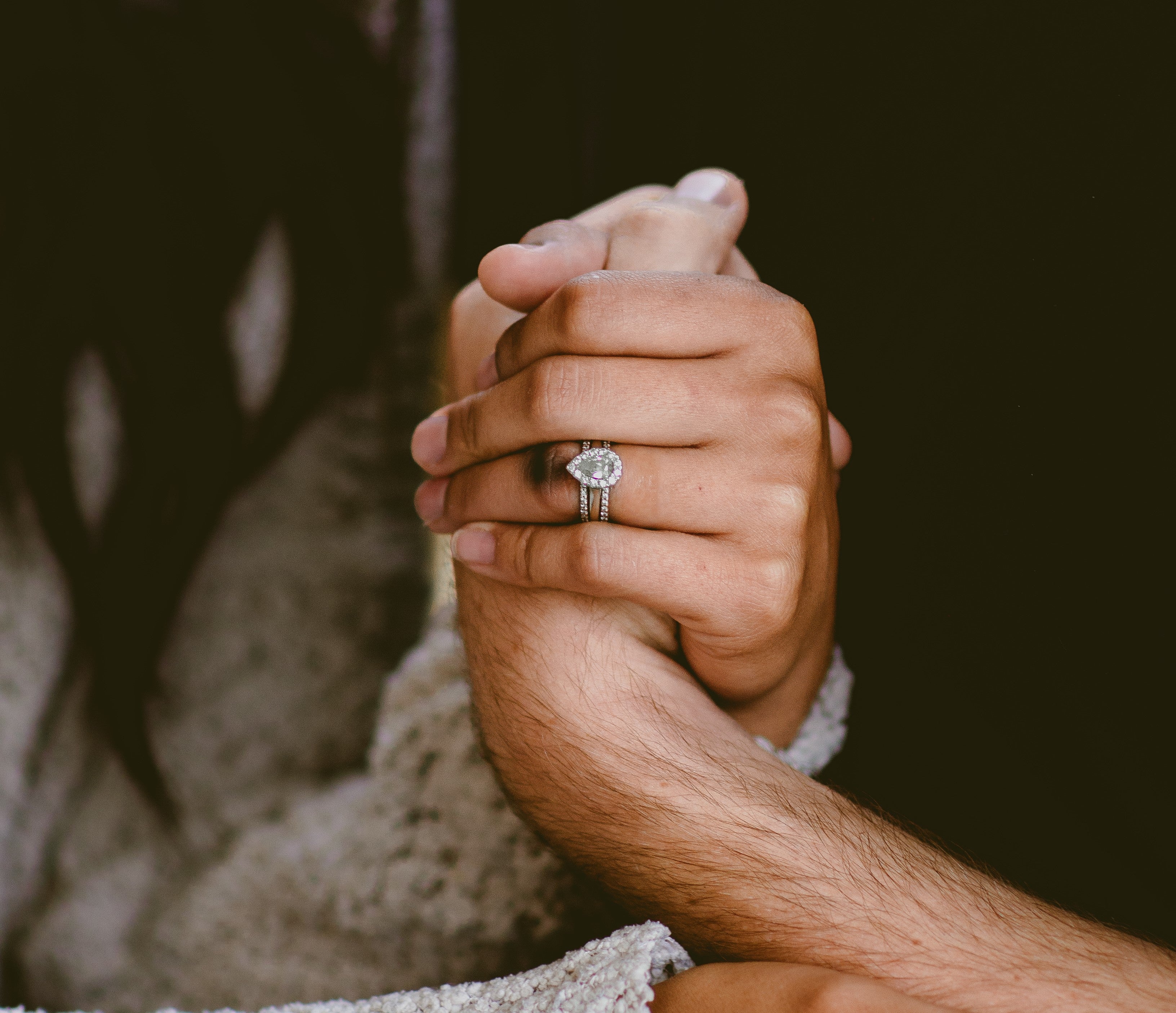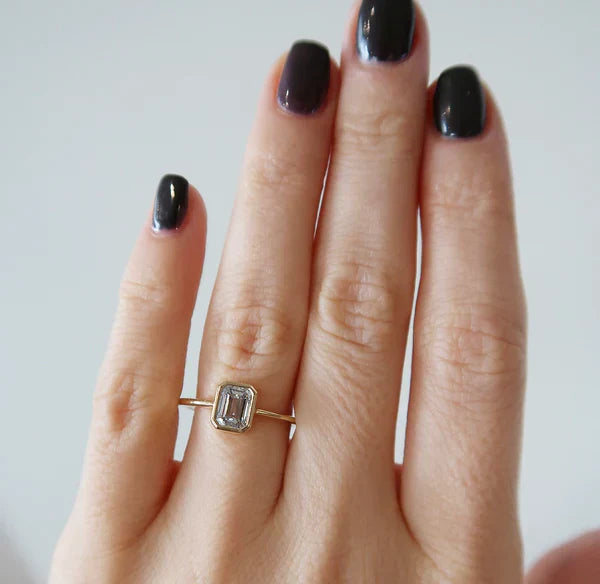
How to Wear An Engagement Ring and Wedding Band
Traditionally, the wedding band is worn first, closest to the heart and on the left ring finger, with the engagement ring placed on top. This sequence symbolises marriage as the foundation of your relationship, followed by the love story that led to it. However, there’s no single correct way to wear your rings. Many couples choose an arrangement that suits their style, comfort, or cultural background better. Our useful guide can help you decide how to wear your engagement ring and wedding band in a way that suits you best.
How to Wear Engagement Ring and Wedding Band the Classic Way
In most Western traditions, including those in Canada, the order is clear: wedding ring first, then engagement ring. Here's a breakdown of the reasoning behind this sequence:
-
Wedding band closest to the heart: The wedding ring is placed on the finger first during the ceremony, symbolising the official commitment made on the wedding day.
-
Engagement ring on top: The engagement ring, representing the journey that led to marriage, is worn on top as a complement to the band.
This classic approach to wearing an engagement ring and wedding band reflects symbolism and a linear relationship timeline.
Is There a Right or Wrong Way to Wear Your Rings?
While tradition suggests the wedding ring comes first, personal preference plays a bigger role than ever in how couples wear their rings today. Here are a few of the more popular modern alternatives:
-
Engagement ring first: Especially common when the engagement ring features a large or unique centre stone. It can be more visually balanced and more comfortable worn on the outside.
-
Separate hands or fingers: Some people choose to wear their rings on different hands or fingers altogether, especially if both rings are substantial in size.
-
Soldered sets: Joining the engagement ring and wedding band together through soldering ensures they stay aligned and prevents rubbing between them.
Ultimately, there’s no universal rule. The right way to wear your engagement ring and wedding band is the one that feels right for you.
Cultural Variations in Wearing Engagement and Wedding Rings
Cultural traditions also shape how to wear engagement rings and wedding bands. In Canada, rings are typically worn on the left ring finger, but this isn't consistent worldwide.
-
Right-hand ring wearing: In countries such as Russia, Greece, Colombia, and India, both the engagement and wedding rings are commonly worn on the right hand.
-
German and Dutch tradition: The engagement ring is worn on the left before marriage and moved to the right after the wedding.
-
Jewish wedding customs: In some traditions, the wedding ring is placed on the right hand during the ceremony and moved to the left afterward.
These regional differences reflect how ring placement is just as symbolic as it is personal.
Choosing the Best Ring Order Based on Ring Design
Some ring styles are meant to be worn in a specific way based on their design. This can affect comfort, appearance, and even long-term wear.
Consider the following when deciding how to wear your engagement ring and wedding band:
-
Stacking shape: If your engagement ring has a curved or halo setting, it may not sit flush with a flat wedding band.
-
Matching sets: Bridal sets are often designed to nestle in a specific arrangement—usually with the wedding band underneath.
-
Durability and wear: Rings made from softer metals like gold can wear down if constantly rubbing against a harder ring. Choosing a wearing order that reduces friction can help preserve both pieces.
For those considering custom rings, it's helpful to plan the stack to avoid future fit or aesthetic issues.
Comfort-First Approach to How to Wear Engagement Ring and Wedding Band Daily
For most people, comfort is the deciding factor when it comes to ring order. Engagement rings with large stones or raised settings can snag on clothes, gloves, or even hair, especially when worn on the inside.
To make sure both rings feel natural for everyday wear:
-
Size both rings together: This ensures a balanced fit, which is particularly important if stacking both on one finger.
-
Consider soldering: Some people opt to have their rings permanently joined for alignment and added security.
-
Use spacers: Thin, often barely visible rings placed between the band and engagement ring help prevent metal-on-metal wear.
-
Take rings off when necessary: Protect your rings (and fingers) by removing them during workouts, housework, or skincare routines.
If a particular order feels uncomfortable, there's no harm in experimenting with alternatives until it feels right.
Where an Eternity Ring Fits When Wearing Multiple Bands
As more couples celebrate milestones with eternity rings, there's often confusion about where they belong in the stack. These rings, typically encrusted with diamonds or gemstones, can be worn in a few different ways:
-
After the wedding and engagement rings: This is the most traditional placement.
-
Between the engagement and wedding ring: Creates a balanced look, particularly if all three rings match in style or metal.
-
On the opposite hand: A practical option if stacking all three rings on one finger feels tight or bulky.
As with engagement and wedding rings, placement often depends on style, comfort, and how well the rings complement one another.
How to Wear Engagement Ring and Wedding Band During the Ceremony
A common question for brides is whether or not to wear their engagement ring during the ceremony. There are a few common approaches:
-
Move it to the right hand temporarily: This leaves the left ring finger clear for the wedding band to be placed first.
-
Leave it off for the ceremony: The engagement ring can be added afterward during a private moment or reception.
-
Wear it as usual: Some couples don’t mind placing the wedding ring on top of the engagement ring, particularly if the order will be swapped post-ceremony.
Whatever option you choose, plan so there’s no fumbling during the ceremony.
Smart Ring Stacking for Comfort and Longevity
If you plan to wear your engagement ring and wedding band daily—and possibly an eternity ring as well—smart stacking will keep them looking great and feeling comfortable.
Helpful stacking tips include:
-
Use contour or chevron bands that align neatly with the engagement ring shape
-
Choose similar band widths and profiles to prevent imbalance
-
Keep sharp edges to a minimum to reduce skin irritation
-
Schedule routine inspections with a jeweller to check prongs and settings
When rings are worn together every day, subtle shifts in fit and alignment can occur over time. Being proactive helps prevent damage.
How to Wear Engagement Ring and Wedding Band in a Way That Works for You
Wearing your wedding and engagement rings in a traditional order is a lovely nod to symbolism, but there’s no rulebook. Whether you wear your rings in the customary left-hand stack or create a layout unique to you, the most important thing is that it reflects your relationship and lifestyle.
In short:
-
Wedding band first is traditional and meaningful
-
Engagement ring first works better for some styles
-
Some wear them on different hands or solder them together
-
Cultural practices may differ
-
Comfort and practicality matter most
Conclusion
When choosing how to wear your engagement ring and wedding band, take the time to try a few arrangements and consider how they’ll feel weeks, months, and years from now. The right answer is the one that fits you best, iterally and figuratively.


